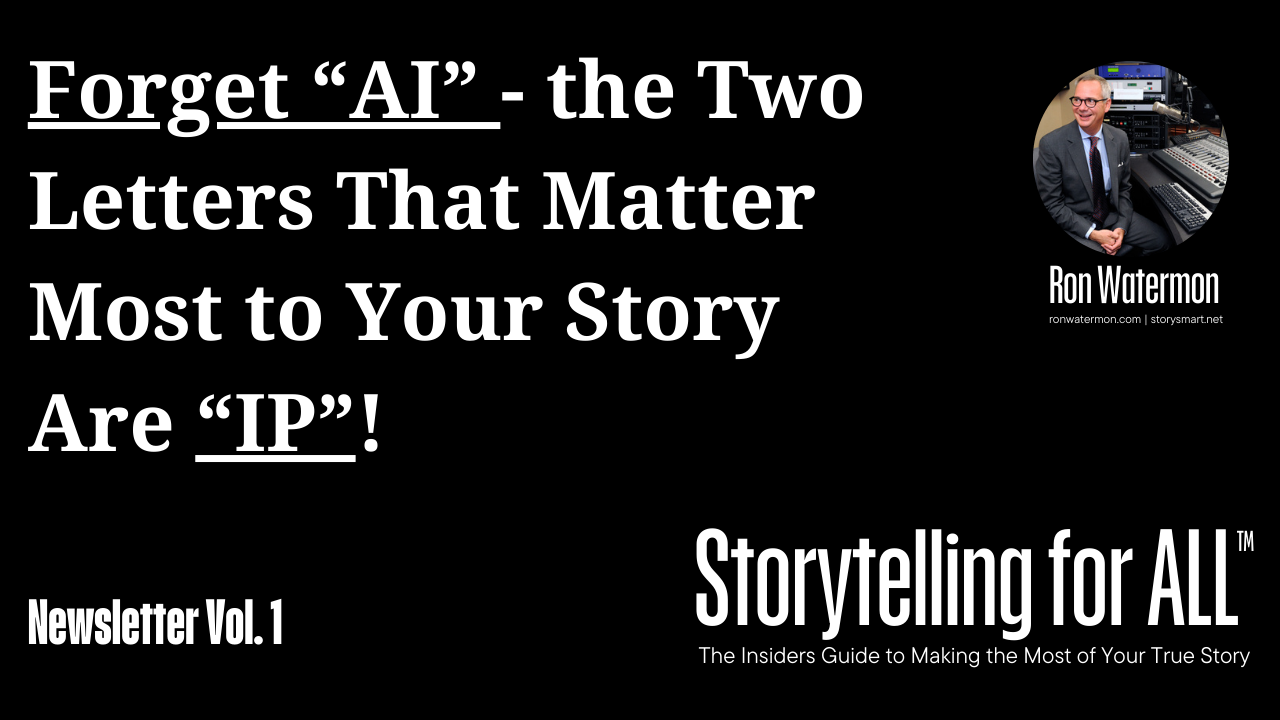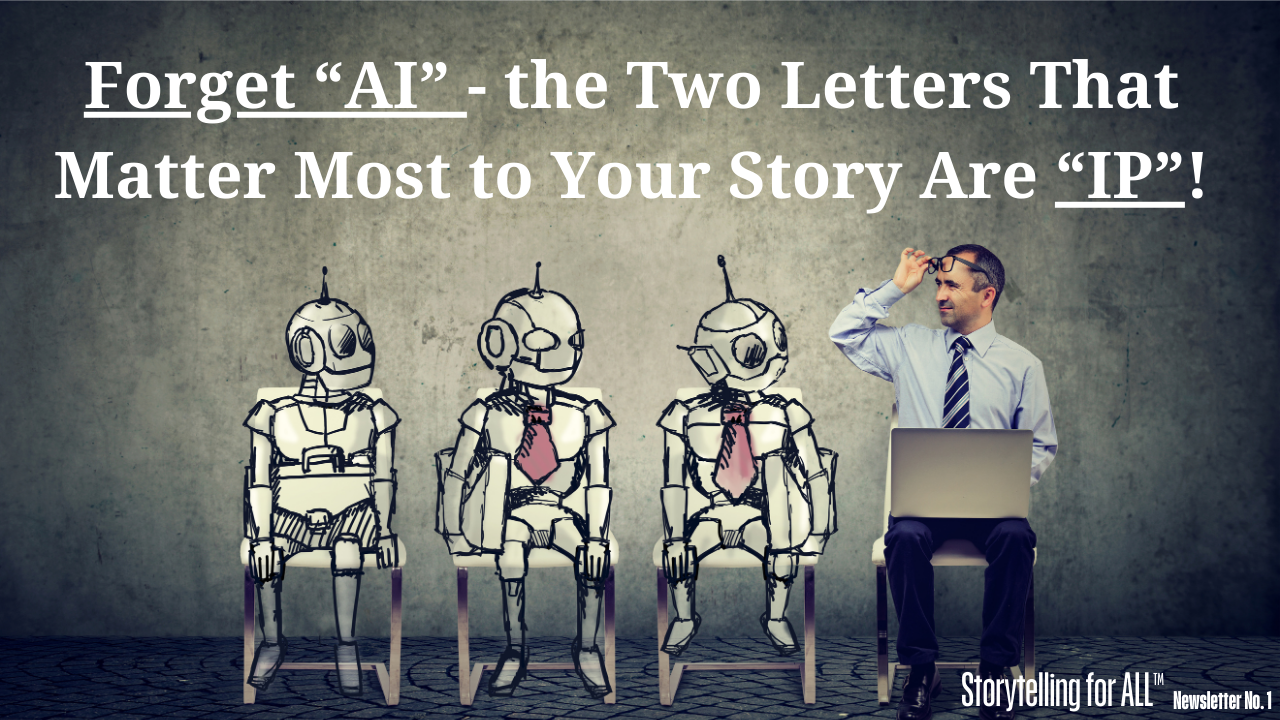Forget AI - the Two Letters That Matter Most to Your Story Are IP!
Storytelling for ALL ™ LinkedIn Newsletter Vol. 1

Right now, the world is buzzing about two letters: A and I. Artificial Intelligence.
You can’t scroll LinkedIn, turn on the news, or open your email without seeing someone touting it as the biggest technological shift since the internet — or warning it will upend entire industries and lead to job losses.
And here’s the truth: they’re not wrong.
AI is a game-changing tool. It’s already reshaping how stories are researched, written, edited, and even visualized. If you’re a storyteller — or you have a true story worth telling — AI can speed up your process, make brainstorming easier, and open creative doors you didn’t even know existed.
But it’s not the most important thing you should be thinking about if you want your story to be told well and on your terms.
Because there are two other letters that should matter much more to you than AI:
I & P. Intellectual Property. That is the real game-changer.

Intellectual Property: The Real Game-Changer
“IP” stands for Intellectual Property — the foundation of ownership, control, and profit in the storytelling business. It is the single most important thing you should focus on as you produce your story.
Here’s the simplest way to put it: You can use AI (or any tool) to make storytelling faster and flashier. But if you don’t own the underlying intellectual property, you don’t own the story.
And if you don’t own the story, you can’t control how it’s told, who tells it, or how you benefit from it. I’m here to tell you that this is something most people miss.
The Myth of the Binary Choice in Storytelling.
One of the biggest misconceptions I see — and I talk about this in my book STORYSMART® Storytelling for ALL™ — is the idea that you have only two options for telling your story:
- Do it yourself. Write the book, shoot the documentary, produce the series on your own dime. You own it, sure, but you carry all the cost, risk, and work.
- Sell your rights. Hand over your life story to a publisher, producer, or studio in exchange for a check and maybe some exposure — but little to no creative control.
For most people, that’s where the conversation ends. They pick between those two doors… or they do nothing.
But that’s a false choice. There is a better way.
Become A Storypreneuer With A Media Mogul Mindset
Don't think so binary. There is a third option. There is a better way — and it starts with adopting what I call a Media Mogul Mindset.
I want you to think like a studio executive, but apply it to your own true story. Pretend you are the executive of Paramount or Disney or Warner Brothers, and you want to make the most of your story.
Here’s the core of that mindset:
- Your story is an asset.
- Your intellectual property is the blueprint.
- The right creative team is your production engine.
Instead of selling your rights or trying to DIY the whole thing by yourself, you retain ownership of the IP and bring in the best storytellers — screenwriters, directors, producers — to adapt your vision. You have to pay attention to important details (ex. Work-for-hire agreements etc.), but you can work the same way studios work with top creative talent. The difference is, you are the head of your own independent studio.
Haven’t you ever wondered why almost every Hollywood actor eventually forms their own studio? They quickly figure out that ownership is the key to real wealth and having some control over their career. I challenge you to watch industry insiders and learn what they do.
Why This Matters More Than Ever.
AI can write scripts, edit footage, create pitch decks, and even generate concept art. That’s powerful. But none of it means anything if you haven’t taken steps to control your intellectual property from day one.
Because here’s the uncomfortable truth: If someone else owns your IP, they can feed your story into their own AI — and churn out books, films, podcasts, and spin-offs without you having any say or share.
On the flip side, if you own the IP, you decide:
- How the story is told.
- Who gets to adapt it.
- What formats it takes (book, film, series, documentary).
- How the revenue is shared.
That’s where the real leverage is. One quick caveat to using AI. Be careful. If something is AI generated, it can’t be copyright protected. You need to be very careful and consult a good IP attorney to ensure you are smart about using AI during your creative process.
The STORYSMART® Framework in Action
Here’s how you can shift from “passenger” to “studio head” in your own story:
- Document Your Story Get it down in a form that’s recognizable as storytelling source material — a memoir, treatment, interview transcripts, or even a short-form sizzle reel. Focus on creating copyright-protected storytelling source material. This is typically the most important investment our clients make. Memories can’t be copyrighted, but memories committed to a tangible medium can be. Copyright protects original works of authorship (by a human not AI) that are fixed in a tangible medium of expression. That means a video, a written document, an audio recording etc.
- Secure the Rights Work with a qualified entertainment/IP attorney to make sure you own and control the material. If others were involved in developing or recording your story, get work-for-hire agreements or assignments of rights where needed. You can’t just hire a video crew to go get interviews for you and expect to own it. The law protects the creator of content (photographer, writer etc.), not necessarily the person that paid for it. The biggest mistake I see made is assuming you own what you paid for. When it comes to hiring a creator like a photographer or videoagrapher, absent an express agreement conveying copyright to you, you don’t. You may not realize you don’t own your wedding photos – you simply have a limited license (unless your agreement with your wedding photographer conveyed copyright).
- Assemble Your Creative Team Hire the best storytellers you can afford — people who understand your vision and can elevate it. You’re not “giving them your story”; you’re engaging them to help you tell it in the most powerful way. The best storytellers can add value to your story. Make it worthwhile for them to help you tell your story. You won't regret it.
- Retain Creative Oversight Build this into your contracts. You don’t have to micro-manage, but you should have a seat at the table for major creative decisions.
- Think Multi-Platform Approach your story like a studio slate. A book can lead to a documentary. A podcast can spark interest for a scripted series. Every adaptation should ladder back to your owned IP.
Why Most People Miss This
In the rush to “get their story out there,” people make the same two mistakes:
- They hand over their rights too soon because a publisher or producer seems like the only path forward.
- They wait too long and lose momentum — or worse, someone else tells a version of their story first.
The Media Mogul Mindset flips that script. You build and protect the IP first, then choose your partners.
AI Is Just a Tool — IP Is the Asset
Here’s the thing: AI is exciting, but it’s just one of many tools that will come and go. Intellectual property? That’s timeless. It’s the currency of the storytelling business.
Think of AI as a high-performance car. Your IP is the title and registration. It doesn’t matter how fast or sleek the car is — if your name’s not on the title, it’s not really yours.
Your Next Move
If you want to future-proof your story, stop worrying about AI replacing you and start thinking like a Storypreneuer.
- Document your story.
- Protect it legally.
- Approach it like a slate of projects with multiple revenue streams.
- Engage the right creative team to bring it to life.
Do that, and you’ll be in control no matter how technology evolves — because you’ll own the thing that matters most: your Intellectual Property (IP).
Final Thought
In the end, AI might help you tell your story faster, better, and more beautifully. But IP will ensure it’s your story — told your way, with you in the credits and the contracts.
If you’re ready to start that process, suscribe to this newsletter. I'd also encourage you to join our free STORYSMART® Community at storysmart.net/storyforall. You’ll get tools, templates, and guidance to take control of your story from day one — and make the most of it for years to come.
About the Storytelling for ALL™ Newsletter
The Storytelling for ALL™ LinkedIn Newsletter is a guide to making the most of your true story. Twice a month, I'll share proven strategies, creative approaches, and industry-tested tools to help you take control of your narrative, protect your rights, and collaborate with great storytellers to bring your vision to life.
You’ll get practical, actionable insights to adapt your story into a book, film, documentary, or legacy preservation project — using the same approaches that top professionals rely on, now made accessible to you. Whether you’re an athlete, public figure, entrepreneur, or someone with a story worth telling, this is where you’ll learn to share it — on your terms.
Join the conversation with #StorytellingForALL and reach out to me personally if I can help.











